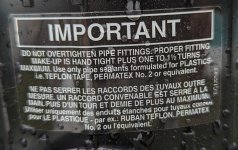I replaced our pump and was up and running for about a week and then noticed the (Hayward) valve cracked at both inlet and return fittings. Kind of chalked it up to old brittle valve body and/or me overtightening the pipes into it and bought a brand new valve.
The new one I deliberately assembled much looser -- didn't even touch it with the pipe wrench. And, again, I was up and running for a few days with no issues, only to find it cracked and dribbling again. We have had some overnight freezes and have had the pump running at 1500rpm during those spells.
I'm hesitant to swap it out a third time for fear of the same result. Pipes in are normal 1.5" white PVC and I've been using Rectorseal Tru-Blu thread sealant. Really did not come even close feeling like I was forcing anything the second go-round.
The new one I deliberately assembled much looser -- didn't even touch it with the pipe wrench. And, again, I was up and running for a few days with no issues, only to find it cracked and dribbling again. We have had some overnight freezes and have had the pump running at 1500rpm during those spells.
I'm hesitant to swap it out a third time for fear of the same result. Pipes in are normal 1.5" white PVC and I've been using Rectorseal Tru-Blu thread sealant. Really did not come even close feeling like I was forcing anything the second go-round.








